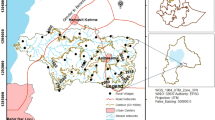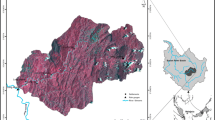Abstract
Since the mid eighties, agricultural development and increased population growth in Vietnam’s northern highlands have modified land use patterns and thus, increased the runoff process and soil degradation induced by water erosion. In the last decade, Vietnamese literature has focused on the computation of soil losses over large areas. Most of these spatial and quantitative soil erosion studies do not consider the impact of agricultural land use diversity (spatial heterogeneity), particularly at the watershed scale, and the annual variability of seasonal landscape factors on soil erosion vulnerability and hence, landscape dynamics. We present an integrated approach combining field measurements and observations, GIS and modeling to determine the spatial and temporal dynamics of soil erosion vulnerability according to watershed units and hence, the impact of physical environment components and agricultural land use patterns on landscape evolution. Tables and graphics showing the cropping systems, the periods within a year, and the watershed units that are most vulnerable are presented. The double cultivation cycles for paddy rice fields not only imply two periods of land preparation and establishment that expose the soil surface to raindrop impacts, but also increased soil management practices that decrease the soil’s resistance to detachment. Despite the low levels of soil management practices for the shifting cultivation system, the near absence of soil conservation practices clearly increases their vulnerability. Hence, rainfed cropping systems, mainly soya and cassava, cultivated on sloping lands (hills and mountains) where soil erosion vulnerability is the highest represent the watershed units which are the most prone to soil loss.
Similar content being viewed by others
References
Boggs G, Devonport C, Evans K, Puig P (2001) GIS-Based rapid assessment of erosion risk in a small catchment in the wet/dry tropics of Australia. Land Degrad Dev 12:417–434
Bonn F (1998) La spatialisation des modéles d’erosion des sols à l’aide de la télédétection et des SIG: possibilités, erreurs et limites. Sécheresse 19(3):185–192
Carson MA, Kirkby MJ (1972) Hillslope form and process. Cambridge University Press, London England
Cohen MJ, Shepherd KD, Walsh MG (2005) Empirical reformulation of the universal soil loss equation for erosion risk assessment in a tropical watershed. Geoderma 124(3):235–252
Dijk AIJM, Bruijnzeel LA (2001) Modelling rainfall interception by vegetation of variable density using an adapted analytical model. Part 2. Model validation for a tropical upland mixed cropping system. J Hydrol 247:239–262
Elwell HA (1978) Soil loss estimation. Compiled works of the Rhodesian multidisciplinary team on soil loss estimation. Cyclo. Salisbury. In: Morgan RPC (ed) 1995. Soil erosion & conservation. 2nd edn., Longman group, John Wiley & Sons Inc, New York, NY, USA, p 71
Elwell HA (1978) Soil loss estimation. Compiled works of the Rhodesian multidisciplinary team on soil loss estimation. Cyclo. Salisbury. In: Morgan RPC 1995. Soil erosion & conservation, Second Edition, Longman group, John Wiley & Sons Inc, New York., NY, USA, p 71
FAO (1998) Topsoil characterization for sustainable land management (Draft). Land and Water Development Division Soil Resources, Management and Conservation Service, Rome Italy, p 71
Hudson N (1971) Soil conservation. Cornell University Press, Ithaca, NY, USA
Jain MK, Kothyari UC (2000) Estimation of soil erosion and sediment yield using GIS. Hydrol Sci 45(5):771–786
Jain SK, Kumar S, Varghese J (2001) Estimation of soil erosion for Himalayan watershed using GIS technique. Water Res Manage 15:41–54
Kalpagé FSCP (1974) Tropical soils: classification, fertility and management. Macmillan Company of India Limited, India
Lai Vinh C (2000) Soil erosion study in northwest region of Vietnam by integrating watershed analysis and universal soil loss equation (USLE). Vietnam Natl Univ J Sci: Nat Sci 11:142–150
Le Trong T, Eames JC, Kuznetsov AN, Nguyen VS, Bui Xuan P Monastyrskii AL (2001) A biodiversity survey and assessment of the Dong Phuc, Ban Thi-Xuan Lac and Sinh Long areas, Tuyen Quang and Bac Kan Provinces, Vietnam. Creating Protected Areas for Resource Conservation using Landscape Ecology (PARC) Project, Na Hang/Ba Be Component, Ba Be National Park, Be Be District, Bac Kan Province, Vietnam, p 55
Mati BM (1995) The effect of rainfall characteristics on splash erosion under crop covers. Trop Agric (Trinidad) 72:1:18–22
Mati BM, Morgan RPC, Gichuki FN, Quinton JN, Brewer TR, Liniger HP (2000) Assessment of erosion hazard with the USLE and GIS: a case study of the Upper Ewaso NG’iro basin of Kenya. International Int J Appl Earth Observ Geoinformat 2(2):78–85
Millward AA, Mersey JE (2000) Adapting the RUSLE to model soil erosion potential in a mountainous tropical watershed. Catena 38(2):109–130
Mitasova H, Hofierka J, Zlocha M, Iverson LR (1996) Modeling topographic potential for erosion and deposition using GIS. Int J Geogr Informat Sci 10(5):629–641
Mitasova H, Mitas L, Brown WM, Johnston D (1998) Multidimensional soil erosion/deposition modeling and visualization using GIS. Final report for USA CERL. University of Illinois, Urbana-Champaign Illinois
Morgan RPC (1995) Soil erosion & conservation, 2nd edn. Longman group, John Wiley & Sons Inc, New York NY USA
Mulengera MK, Payton RW (1999) Estimating the USLE-soil erodibility factor in developing tropical countries. Trop Agric (Trinidad) 76(1):17–22
Nguyén QM, Le TC (1990) Observation of soil erosion in Vietnam. Vietnam National University, Hanoi Vietnam
Nguyén QM (1992) Initial research of present geo-environment in Vietnam. Regional Seminar on Environmental Geology, November 11–13, Hanoi University, Vietnam, pp 105-111
Renard KG, Freimund JR (1994) Using monthly precipitation data to estimate the R-factor in the revised USLE. J Hydrol 157:287–306
Renard KG, Foster GR, Weesies GA, McCool DK and Yoder DC (1997) Predicting soil erosion by water: a guide to conservation planning with the Revised Universal Soil Loss Equation (RUSLE). U.S. Department of Agriculture, Agriculture Handbook no. 703, USA, p 404
Roose E (1999) Introduction à la gestion conservatoire de l’eau, de la biomasse et de la fertilité des sols. GCES, Bulletin pédologique de la FAO
Stone RP, Hilborn D (2000) Universal Soil Loss Equation (USLE). Ontario Ministry of Agriculture and Food, Agriculture and Rural Division; Factsheet, order no.00-001, ISSN: 1198-712X. http://www.gov.on.ca/OMAFRA/english/engineer/facts/00-001.htm
Thai P, Mai VT, Do CD (2001) Érosion du sol sur les rÉgions de collines, District Ninh Son, province de Ninh Thuan. Vietnam Soil Sci 15:161–169
Tran K, Le Thai B (1999) Land environment (report on actual land environment in Vietnam). Ministry of Science, Technology and Environment, Hanoi Vietnam, p 21
Turkelboom F, Poesen J, Ohler K, Van Keer K, Ongprasert S, Vlassak K (1996) Assessment of tillage erosion rates on steep slopes in northern Thailand. Catena 29:29–44
Vaesen K, Gilliams S, Nackaerts K, Coppin P (2001) Ground-measured spectral signatures as indicators of ground cover and leaf area index: the case of paddy rice. Fields Crops Res 69:13–25
Wall GJ, Coote DR, Pringle EA, Shelton IJ (2002) RUSLEFAC-Revised Universal Soil Loss Equation for application in Canada: a handbook for estimating soil loss from water erosion in Canada. Research Branch, Agriculture and Agri-Food Canada, Ottawa, Canada, pp 53–60
Williams CN, Joseph KT (1970) Climate, soil and crop production in the humid tropics. Oxford University Press, Ely House, London, Great Britain
Wischmeier WH, Smith DD (1981) Predicting rainfall erosion losses -a guide to conservation planning. Supplement to Agriculture Handbook No. 537. USDA, Washington DC, USA, p 58
Wu J, Hobbs R (2002) Key issues and research priorities in landscape ecology: an idiosyncratic synthesis. Landscape Ecol 17:355–365
Zingerli C, Castella J-C, Pham Hung M, Pham VC 2002 Contesting policies: rural development versus biodiversity conservation in the Ba Bê National Park Area. Hanoi, Vietnam, p 14
Author information
Authors and Affiliations
Corresponding author
Rights and permissions
About this article
Cite this article
Vezina, K., Bonn, F. & Van, C.P. Agricultural land-use patterns and soil erosion vulnerability of watershed units in Vietnam’s northern highlands. Landscape Ecol 21, 1311–1325 (2006). https://doi.org/10.1007/s10980-006-0023-x
Received:
Accepted:
Issue Date:
DOI: https://doi.org/10.1007/s10980-006-0023-x




